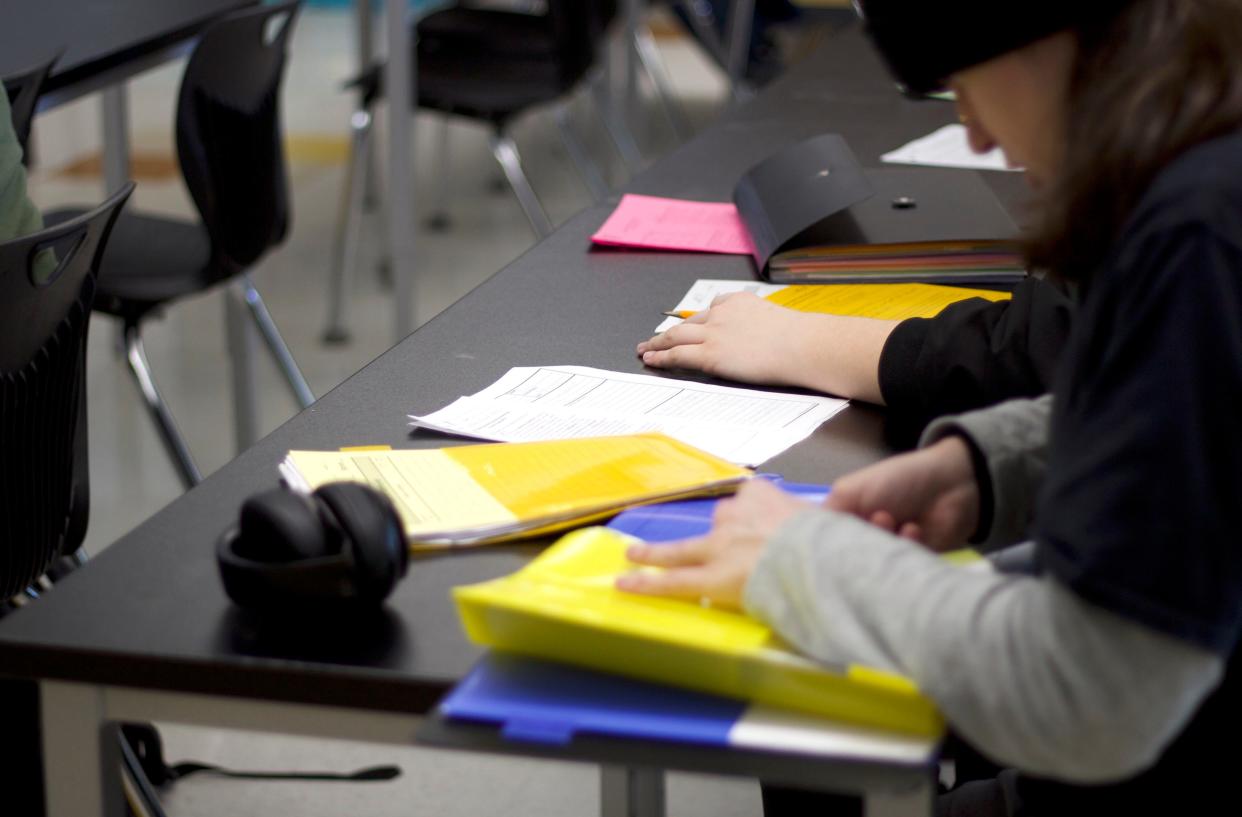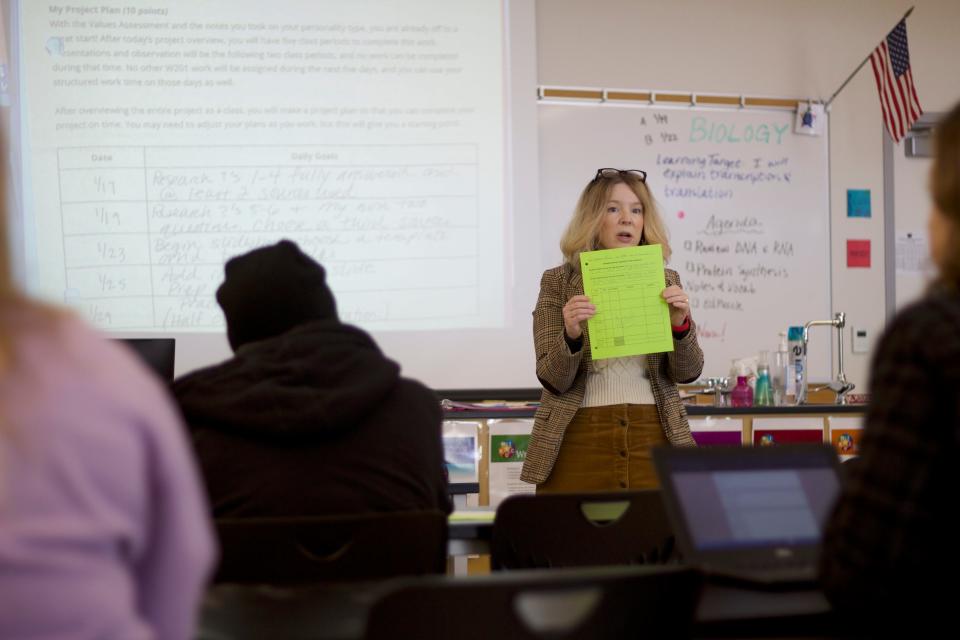Oregon graduation rates remain steady and high statewide, Willamette High highest in Eugene/Springfield

Oregon schools remained stable with their graduation rates for the 2023 cohort, tying their second-highest-ever high school graduation rate.
The Oregon Department of Education publicly released its annual graduation data report Thursday. Statewide, 81.3% of 2023 high school graduates graduated in four years, tied with the results from 2022 and second highest only to the 2020 cohort, which had a graduation rate of 82.6%.
“This class of 2023, which entered school in the fall of 2019, were in ninth grade when the pandemic hit, and so they’ve endured the full, multi-year impact of the pandemic on their learning,” said Jon Wiens, ODE’s director of reporting, accountability and data.
Oregon has calculated the rates since 2008. Pre-pandemic, Oregon’s graduation rate had been increasing for about eight years.
While 2023's nearly all-time-high rate is promising, ODE officials said they still had work to do. When asked about whether this stability is good or bad, ODE Director Charlene Williams said amidst the disruption to education, new initiatives played a role in getting students to finish strong.
"This is the cohort that has demonstrated the incredible amount of resilience and given the impacts of COVID," Williams said. "It's easy to look at these numbers and want to assign 'Well, this is what made the difference, or this is why these numbers are the way they are.' But as you know, there's multiple reasons that contribute to their ability to hang on and not backslide."
Williams pointed to initiatives such as the High School Success Act, which distributed $2 million in 2023, and the Student Success Act, which invests approximately $2.35 billion in Oregon education every two years. She said ODE sees teachers pulling individual students who need extra help and following data to ensure students receive the support they need in the classroom.
She also said getting attendance back on track is a core focus of ODE. Students need more time in the classroom, so after school and summer school programs are a key tool for students, according to Williams. She said ODE plans to seek out more funding for summer learning initiatives in the coming legislative session.
Despite the stability from 2022 to 2023, Oregon students have made significant gains in the past ten years, with a 9.3 percentage point increase of students graduating in four years since 2014.
The newest data shows improvements were particularly seen in three groups, which each hit all-time highs.
Former English learners – students who completed an English Learner program before starting high school – graduated at a rate of 87.6%. That’s 6 percentage points higher than the statewide average. Special education students graduated at a rate of 68.6%. And the graduation rate for students experiencing houselessness increased 2 percentage points, to 60.6%.
ODE officials want to eliminate barriers for all student groups including students of color, students in special education, students with disabilities and low-income students.
"Our students who have been historically marginalized in our education systems are continuing to close the gap between their graduation rate and average performance across time," said Dan Farley, ODE's director of assessment. "I think that's a promising practice."
ODE also reported graduation rates for the first time for three new student groups:
Military-connected students: 86.7%
Students who have experienced incarceration or detention: 35.8%
"Recent arrivals," students who arrived in the country within three years of attending high school: 63.3%
Eugene-Springfield sees mixed results
While the state overall remained stable between 2022 and 2023, the Eugene-Springfield metro area saw varied changes in district graduation rates.
Eugene School District 4J remained the most stable with a graduation rate of 80.9% in 2023, just 0.1 percentage point higher than 2022.
Springfield Public Schools reported a 2.4 percentage point drop to 73.9% in 2023. However, this is higher than the district's rate in 2020.
Bethel School District had the highest graduation rate in the metro area with 84.3%. The district also had the largest improvement, with a 2.5% increase from 2022.
Other Lane County graduation results:
District | 2023 graduation rates | 2022 graduation rates |
Bethel | 84.3% | 81.8% |
Blachly | 55.6% | 84.6% |
Creswell | 84.9% | 86b.6% |
Crow-Applegate-Lorane | 92.9% | 88.9% |
Eugene | 80.9% | 80.8% |
Fern Ridge | 71.9% | 63.3% |
Junction City | 79.9% | 78.1% |
Lowell | 79.6% | 81.3% |
Mapleton | 71.4% | 46.2% |
Marcola | 67.4% | 62.8% |
McKenzie | 73.3% | 54.6% |
Oakridge | 57.1% | 52.9% |
Pleasant Hill | 83.8% | 87.7% |
Siuslaw | 72.9% | 69.3% |
South Lane | 71.7% | 71.7% |
Springfield | 73.9% | 76.3% |
Bethel sees all-time-high graduation rates
While Bethel had the highest graduation rate in the metro area, it also had the highest individual school graduation rate. Willamette High School saw 91.5% of its students graduate on time in 2023, an all time high for the school. WHS Principal Dan Hedberg said it's all about creating community and connection.
"We believe in Bethel that a strong sense of belonging, and education that is relevant and responsive will keep students here, and we're seeing that happen," Hedberg said.
This is the second time WHS has had the highest graduation rate in the area, the first time being in 2014.
"We're really, really proud of last year's class and 91.5%," Hedberg said. "We're proud of them engaging at a really high level, as did the class before them, and the class before them, and this being a way of doing in Bethel − finding strong systems and students that are here and ready."
Tuesday morning, the announcements at WHS listed nearly a dozen clubs and activities meeting just that day. Hedberg said expanding these opportunities and making sure each student has somewhere to belong is important to keeping them engaged.

Hedberg hopes to keep expanding those opportunities, ensuring that student affinity groups such as the Black Student Union and Latinos Unidos have space at the school. The district is also looking to offer expanded activities and clubs at the middle school level to start that engagement earlier.
Another key component that Hedberg attributed the graduation rate to was the school's Wolverine 101 and Wolverine 201, the former is essentially a high school introductory course for freshmen and the latter is for sophomores to help them succeed in high school and beyond.
Bethel Superintendent Kraig Sproles pointed to Bethel's student profiles that the district has been developing. The profiles note traits and characteristics the district wants to help students develop, such as teamwork, creativity and compassion.
"We're not in the business of creating doctors, or teachers, or journalists, or whatever, we're in the business of creating people and having people be agents of change in their own world," Sproles said. "We're thinking characteristically, we want curious, kind, compassionate, collaborative problem solvers. That's what we need in the world."
Sproles added that he doesn't know what the job system might look like in 2060, but he knows these core principles will always be valuable.
Sproles said the graduation rate isn't just a reflection of one year, the final year of a high school student's career, it's a reflection of all their 13 years in the school system.
"These students have been loved and supported and seen as individuals and celebrated for their brilliance, since they've been five years old, in our system," Sproles said.
While WHS thrives, Bethel's alternative school, Kalapuya High, is not being left in the dust. Kalapuya High serves students from grades 10-12. All Bethel students start ninth grade at WHS. If a student isn't succeeding in a traditional high school setting, they may be offered to transition to KHS.
KHS's four-year graduation rate was 46.7%, but the school's five-year completion rate — students who have earned a regular or modified diploma, GED, extended diploma, or adult high school diploma within five years of entering 9th grade − was at 74.1%.
Sproles said the partnership between WHS and KHS are key to Bethel's success and its feeling of community. For graduation, students of WHS and KHS walk the same stage in one ceremony.
"It's not Willamette on its own, it's Willamette and Kalapuya working in partnership to support the heck out of kids to be able to create multiple pathways to walk the stage," Sproles said.
Why is proficiency low when graduation is high?
In order to qualify for graduation in Oregon, high school students must earn 24 credits, complete personalized learning requirements, and demonstrate proficiency in essential skills.
According to 2022 11th-grade proficiency results, which would represent the Class of 2023, 46.9% of students were proficient in English, 20.4% were proficient in math and 31.7% were proficient in science. However, the participation rate in these categories was between 55-64%, so officials said these may not be a full reflection of all student proficiency.
Williams said graduation is more than just assessments.
"Assessments are a huge, huge and important part of our work, it helps us take the temperature of the system, but it's not the only story," Williams said. "We cannot completely dismiss the work that is happening day to day with our professionals are leaders who are working hard and diligently with and for our students... But we definitely need to have a balanced conversation when it comes to assessments."
Williams said in comparison to state assessments, grade point average is considered a more accurate predictor of whether a child will persist in post-secondary education.
In 2023, ODE made the decision to eliminate the graduation requirement of an assessment of essential skills, which often came in the form of tests or capstone projects. Instead of passing a test or completing a capstone, students now demonstrate proficiency in essential skills in the classroom by earning credits.
ODE determined that these essential credit assessments were not the best indicator of post-high school success.
"ODE did some deep research in partnership with the Higher Education Coordinating Commission during the 21-22 school year where we were looking at a decade of data effectively, that demonstrated pretty clearly that the system of social skills policy wasn't impacting the predictability of student experiences for post-secondary outcomes," Farley said.
Miranda Cyr reports on education for The Register-Guard. You can contact her at mcyr@registerguard.com or find her on Twitter @mirandabcyr
Tracy Loew covers education at the Statesman Journal. Send comments, questions and tips: tloew@statesmanjournal.com or 503-399-6779. Follow her on Twitter at @Tracy_Loew
This article originally appeared on Register-Guard: Oregon graduation rates remain steady; mixed results in Eugene/Springfield

